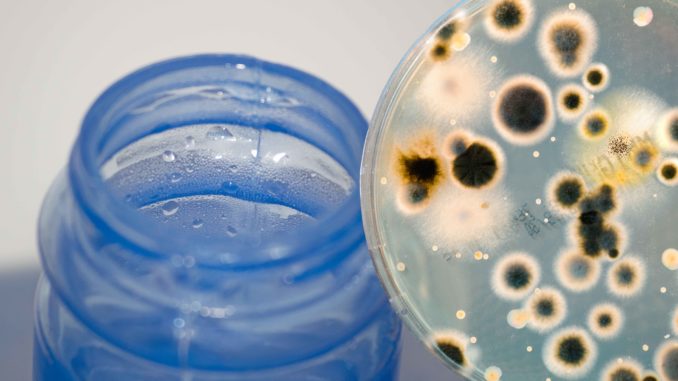
Have you ever noticed how water doesn’t taste the same in all locations? Whether it’s straight tap water, water softened tap water, well water, bottled water, or tap water in a different city, it all tastes different. In fact, the drinking water from my faucet tastes different from the city park drinking fountain one mile from my home. That is because water is susceptible to chemicals, organisms, and the environment that it is exposed to, which changes its taste and quality. Because of its sensitive nature, water can easily be polluted with harmful chemicals, minerals, parasites, and bacteria. Although it is common to find these pollutants in ponds, rivers, and lakes, old water storage is not exempt from being contaminated.
So yes, water can go bad. My personal concern was whether my “old water storage” could go bad if it is stored properly. As I researched the topic, I discovered that there are several opinions and myths about water storage, but very few first-hand accounts of actually testing old water storage. What is my definition of old water storage? Ready.gov recommends rotating water storage every six months. Bottled water typically has a stamped “best if used by date,” ranging from 18 months to 2 years. So anything over two years will be considered old for the duration of this article.
How long can water be stored?
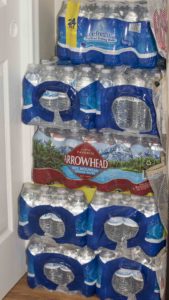
Did you know that about 25% of bottled water is tap water? The main difference in bottled water is that it runs through additional disinfecting stages (other than chemical). One major producer of bottled water uses a carbon filter, microfilter, ultraviolet, and ozone disinfection. That may be the reason that the FDA has stated that bottled water can be stored indefinitely, whereas water storage should be rotated every six months. Chemically treated water, such as bleach, starts losing some of its potency after 6 months.
So what’s all the hype about rotating water?
There are three problems I watch out for with old water storage.
- bad taste
- odor
- contamination
Part of my water storage includes (10) 5-gallon blue water containers. One of the caps is cracked so it does not get an airtight seal. When I do not rotate my water for a long time, it develops a faint odor and has a mild aftertaste. Odor and bad tasting water storage can be a sign that the water is stagnant and just needs to be oxygenized. It could also be a sign that algae are starting to grow. Although it’s generally safe to still consume water storage with some algae, it’s not ideal. However, odor and taste can also be a sign of contamination. Water storage can become contaminated when exposed to vapors from chemicals stored with water storage, leaching from the plastic container, or bacteria from contact with dust, air, and lips. Bacteria can also come from an unsterilized container, bacteria in the hose or faucet, and impure water. Over time, bacteria can grow to unsafe levels making the water unsafe to drink. It’s important to note that water can still be contaminated and unsafe to drink even if there isn’t an unpleasant odor or taste. Getting the water tested is the only way to know for sure.
So yes, it is possible for old water storage to go bad but that possibility can be diminished with the safe handling and storage of water.
I have cases of store-bought water bottles as part of my water storage. After three years, stored in a free from sunlight, 65-degree room, the water tastes the same as a newly purchased water bottle. I’m curious if the 5-gallon water storage and the water stored in old food and juice containers hold up as well. Because it’s recommended to rotate every six months, I’ll be testing the water for bacteria before taste testing it.
Testing My 3 Year Old Water Storage
When my husband & I moved,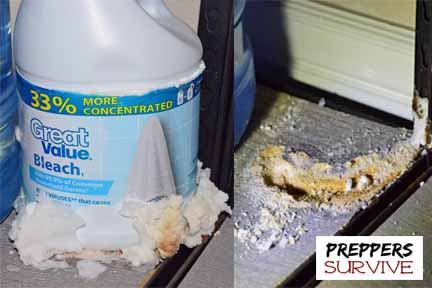 it was a good time to empty our water storage containers and refill them after we were settled. It has been 3 1/2 years since the old water storage was emptied and replaced. Over the years, a few of the caps leaked when I recently tested them. I also stored bleach near them and the bleach went bad, foaming out of the container and making a mess next to the water storage containers. These are two potential threats to my drinking water storage so I wanted to test it for bacteria.
it was a good time to empty our water storage containers and refill them after we were settled. It has been 3 1/2 years since the old water storage was emptied and replaced. Over the years, a few of the caps leaked when I recently tested them. I also stored bleach near them and the bleach went bad, foaming out of the container and making a mess next to the water storage containers. These are two potential threats to my drinking water storage so I wanted to test it for bacteria.
I’ll be conducting 2 separate tests. One on filtered water stored in a blue 5-gallon jug and the other on tap water stored in a sanitized old pickle jar.
Testing Water for Bacteria Experiment
For this experiment, I’m using (2) Bacteria in Water Test Kits from Pro-Labs for two reasons. The first being that it was the cheapest one I could find. The petri dish was the second reason. There are two basic tests that can be purchased for testing bacteria in water. One involves putting your water sample in a purple solution. If it stays purple 48 hours later the water is considered safe to drink. The test I’ve chosen involves mixing your water sample with an agar solution. If the water sample is contaminated with bacteria, I’ll start to see colonies of bacteria growing in the petri dish. This method allows me to see the level of contamination by counting the bacteria colonies.
There are four basic steps to this test:
- Fill the dropper with the water you’ll be testing.
- Add the sample water to the agar solution and turning it upside down twice to mix it.
- Add the solution to the petri dish and leave it undisturbed for 48 hours.
- After 48 hours, count the number of colonies. If it’s 5 or less, it indicates the water is typically safe to drink. Check it again after 72 hours.
Filtered Water Storage
The blue 5-gallon jugs, seen in the photo above, are stored in my basement. As I’ve mentioned, these jugs were filled at a Glacier refill station, 3 1/2 years ago, with filtered water. The room the water is stored in stays about 65 degrees and has blackout curtains to eliminate the exposure to sunlight.
I took a sample from one of the jugs that no longer had an air-tight seal. It would leak around the cap when tipped on its side.
Bacteria are starting to grow in the jug I took the sample from. However, according to the Pro-Lab Test Kit instructions, this water is still safe to drink. The instructions state that 0-5 colonies typically indicates clean water. After completing the bacteria test I poured myself a glass of water for the jug I had sampled. The water had a slight aftertaste and a faint odor. It has been a month since I taste-tested the water storage and so far no stomach problems to report.
Tap Water Storage
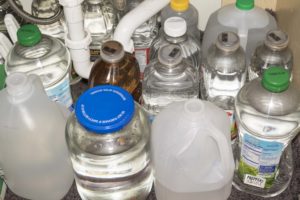
The reused juice, syrup, milk, and pickle containers, you see in the photo above, are stored in a cupboard under a bathroom sink. The pickle jar and several others were filled with tap water 3 1/2 years ago from the sink. The temperature fluctuates between 60-72 degrees in this part of the house. This water storage is labeled “toilet water” and NOT “drinking water” because I wasn’t sure reused food and beverage containers would be free from bacteria. Toilet water is used when the water gets shut-off or the pipes freeze. The stored water is added to the toilet bowl so that we can continue to flush the toilet. The federal standard is less than 1.6 gallons to flush if your toilet is newer than 1992.
Since this is how some people store emergency drinking water it seemed like I should test it to see if it was safe to drink untreated. I chose to sample the water out of the pickle jar because I know the jar had been properly sanitized. It also wouldn’t be prone to leaching since the container is glass and not plastic.
In the picture below there are many bubbles. Each bubble is a bacteria colony. There are over 40 colonies in this sample of pickle jar water storage. Since there are more than 5 colonies, this water is considered unsafe to drink and I won’t be taste-testing it. For information about how to treat contaminated water so that it is safe to drink visit this CDC website.
Related article: Jerry Can Water Filter
How to Preserve Water for Long Term Storage
- Choose a food grade container with a tight seal. Water storage containers are usually labeled for its designed use. However, if I was repurposing a container I would call the manufacturer to verify its food grade. If the manufacturer is unknown, I would check the recycling symbol (a triangle with a number). One through seven are typically food grade plastics but the manufacturer can also use it for paint buckets which are not food grade. The only way to know for sure is to call the manufacturer.
- Rinse out the container with liquid soap and water.
- Sanitize the interior of the container with diluted bleach water (1 quart of water mixed with 1 tsp of bleach). Seal the container then shake it for 30 seconds before dumping out. Then rinse it out with clean water.
- Add drinking water. I wouldn’t use a typical garden hose to fill up a water storage container. Garden hoses have harmful levels of lead and chemicals plus they are rarely sterile. If I needed to use a hose, I would purchase a “Drinking Water Safe Water Hose”. I rotate the water in my 5-gallon containers every 5 years by taking them to a refill station. It cost me 50 cents a gallon. Sometimes I will rotate it early if major events arise or if I suspect contamination. It’s common to only fill up a container three-quarters of the way full if you’re storing your water storage outside. This prevents your container from damage if the water freezes.
- Label the container “Drinking Water” with the date and water source (example: Drinking Water, Oct 2013, Garden Hose).
- Store Properly – Water storage should be keep away from toxic substances, strong odors, and away from sunlight. This can prevent the deterioration of quality in stored water. Keeping the containers away from sunlight slows down the process of algae growth and the weakening of the water storage container. Chemicals find their way on floors by cleaning chemicals or unknown chemicals tracked in from shoes. Garage floors are the worst. To prevent these chemicals on the floor from leaching into your water supply, place cardboard between the floor and your water storage container.
- Test water storage after several years. It provides me with a little peace of mind knowing that I’m preserving water properly. I purchased test kits for around $9-$35 that tests for bacteria. These tests get sold out from time to time (usually during hurricane season) so the price can vary depending on what’s available. The price also varies for a basic bacteria test versus a kit that tests for ten pollutants (Lead, Bacteria, Pesticide, Iron, Copper, Alkalinity, pH, Hardness, Chlorine, Nitrates).
If you’re worried about the water that doesn’t taste good after years of being stagnant in storage, here are some ideas that may help:
A. Oxygenate – Here are two ways to oxygenate:
- pour the water back and forth between two clean containers repeatedly.
- use a battery operated aquarium air pump.
B. Adding water preserver drops to fresh water storage is another way to keep it tasting like it just came out of the tap. Water Preserver Concentrate is designed to kill bacteria, viruses, and fungus for 5 years.
C. Check for leaks. If your water storage doesn’t taste fresh after several years, it may be because your container isn’t airtight. Around the caps are usually the weak point. By placing a water storage container on its side when full, if it’s not airtight, water will start forming around the cap and drip out of the container. There is a greater chance of bacteria forming if the storage container isn’t airtight.
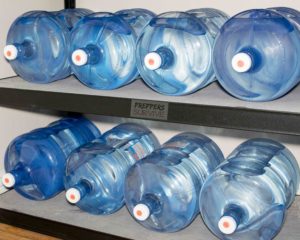
– – – – – – – – – – – – – – – – – – – – – – – – – – –
– – – – – – – – – – – – – – – – – – – – – – – – – – –
– – – – – – – – – – – – – – – – – – – – – – – – – – –
Continue Reading…
– – – – – – – – – – – – – – – – – – – – – – – – – – –
Thanks for visiting Preppers Survive. Before you leave subscribe to our newsletter. If you enjoyed this article, please share it on your favorite social media.
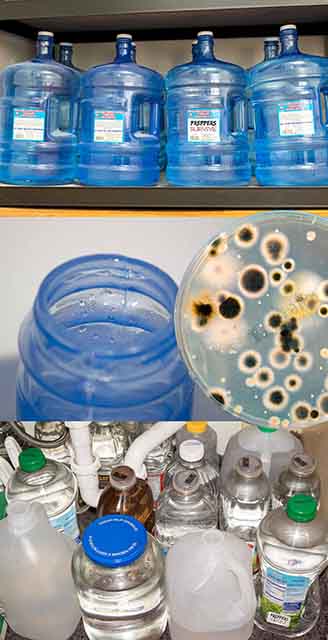


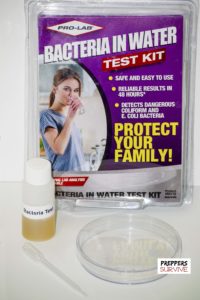
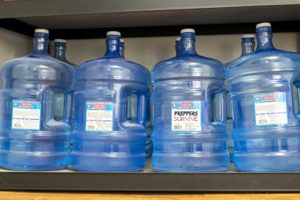
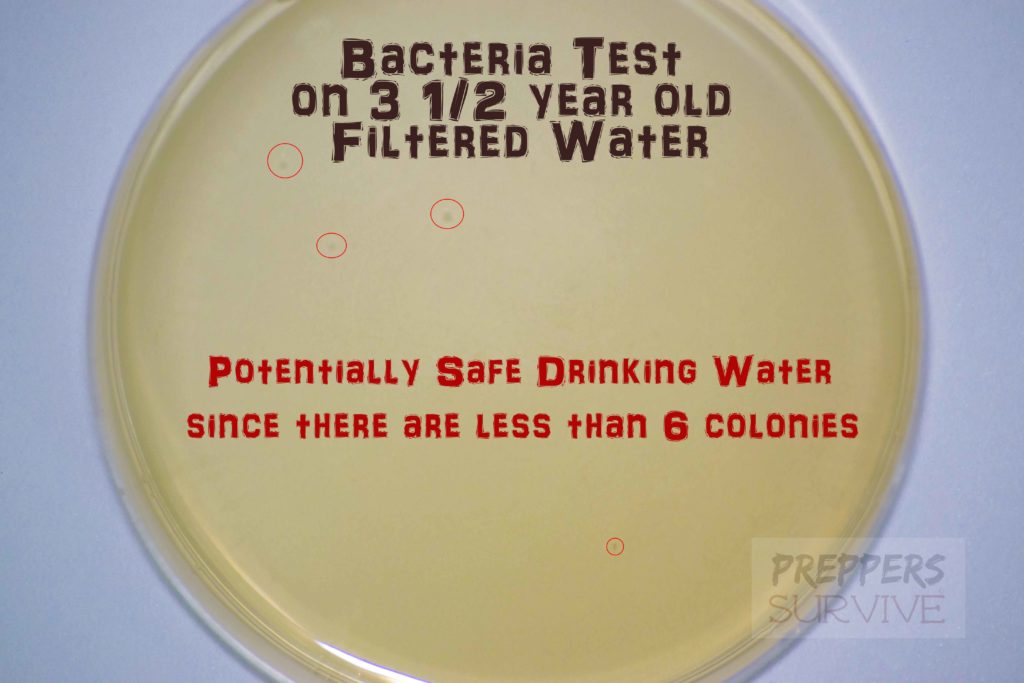
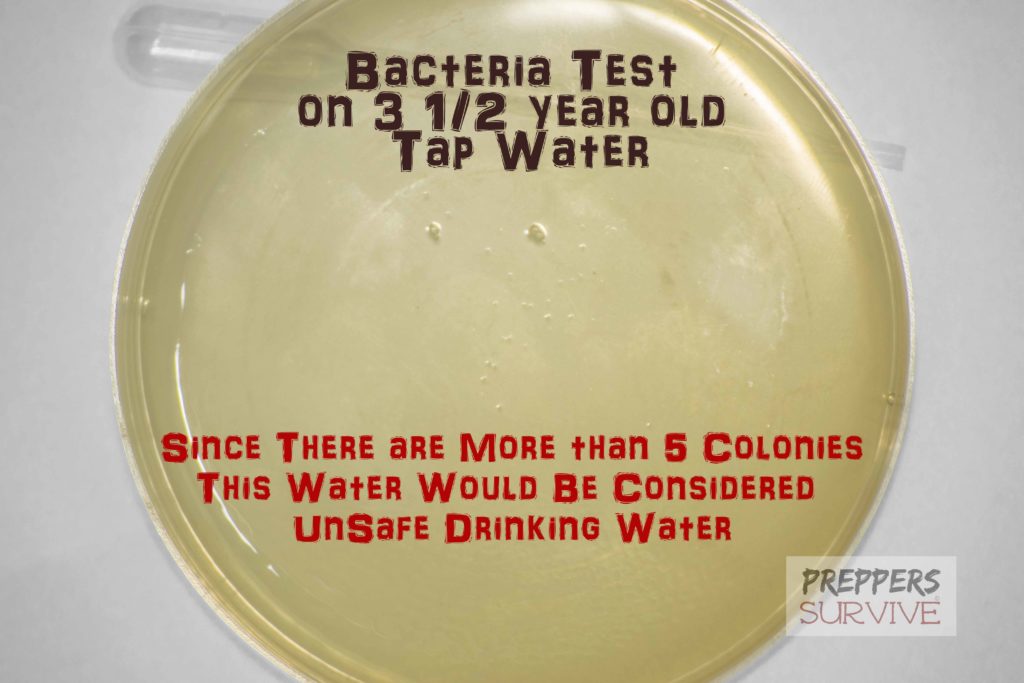
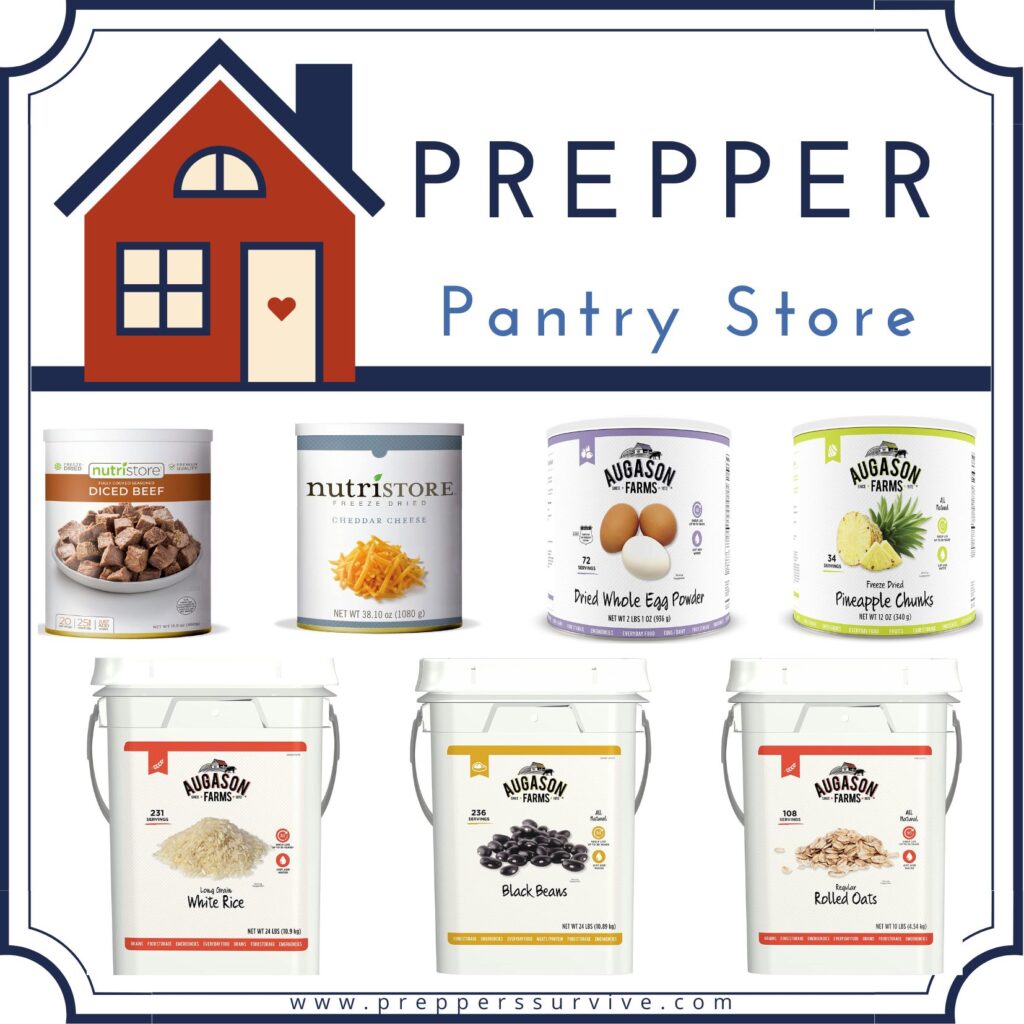
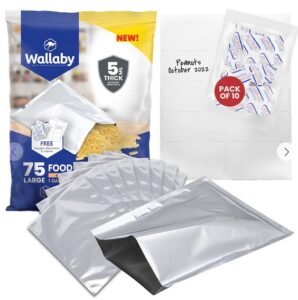
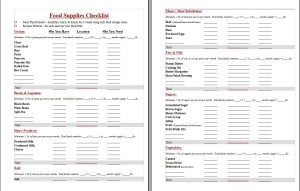
Excellent article on water storage. Many people don’t realize how long they can store water so they either spend to much money switching out to often or don’t even bother storing because they are afraid to drink old water.
Excellent article that I have been waiting for. One question; I have bottled water stored now for 2 years. My question is; can one use survival straws to drink water that might be questionable ??
Survival straws are designed to remove harmful bacteria.
http://www.prepperssurvive.com/what-do-water-filters-remove/
This is very useful information. A lot of us spend too much time and money on rotating our water stockpile. Being informed on this topic will help a lot of us and make our prepping more efficient. I think that we should all have a good stock of survival straws too! We can never be too prepared!
I have always followed the 6 month rule for water storage. Your article was very good and has changed my viewpoint on water storage.
Thanks for the informative post. I’ve also decided to start blogging about preparedness in Finland. https://preppaaja.wordpress.com/
Re the Water Preserver Concentrate…. it appears to be no more stabilized than regular household bleach (it’s still less than 7%), just more concentrated. Would you please look into this? It’s possible that regular household bleach added to water will perform as well, you just will have to add more drops per gallon is all, but it’d be worth confirming before putting out there. Heck of a lot cheaper than $13 for a teeny bottle too. REgards, Frank
I had cases of store bought water that went bad after 2yrs. I keep filters and bleach on hand in case of need.
When storing water in glass jars as you mentioned, what about “canning” the jars? Like you would tomatoes? Wouldn’t that make them last pretty much indefinitly?
Curious for your thoughts – I have 300 gal of outside tap water stored in our garage. It gets little sun light during the day but its warm in there in the summer time (unfortunately we don’t have room in our current house to store it). We assume we’ll store it for a few years and then rotate it. However, if we need it at any time during our storage, we plan to use our Big Berkey water filter to filter it. Would something like that filter out the bacteria that made the water unsafe for drinking?
Thank you for the great information! Thanks also for the link to the CDC on how to make water safer. It looks like boiling water is a great option, but only if you have access to some kind of cooking fuel. I’ll look into an alternative method just in case.
I just realized my husband has 25 bottles of water that is dated “Best by 2010”. He was storing for earthquake survival. I still am unsure whether to dump it or keep it.
Thank you for your research and sharing this information.
I had planned on using ‘expired’ water for non potable uses such as cleaning. Would it be unsafe for washing dishes?